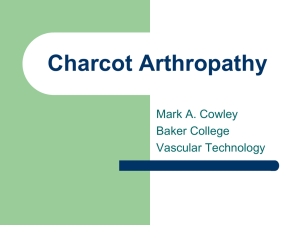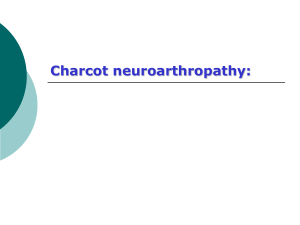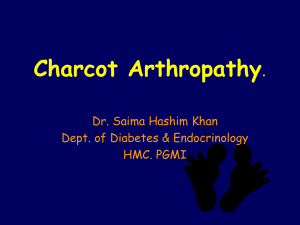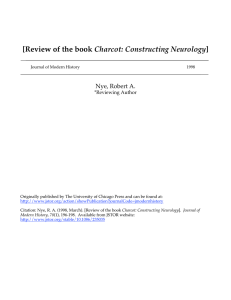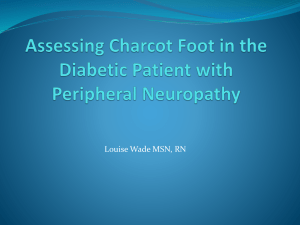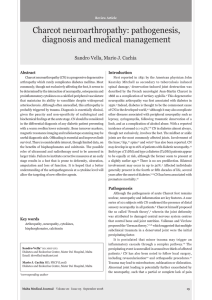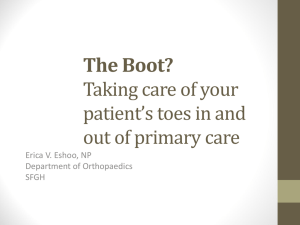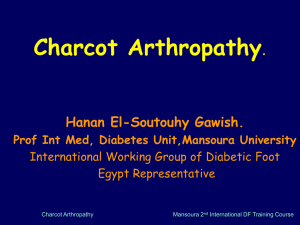Medical Case Conference Call
advertisement
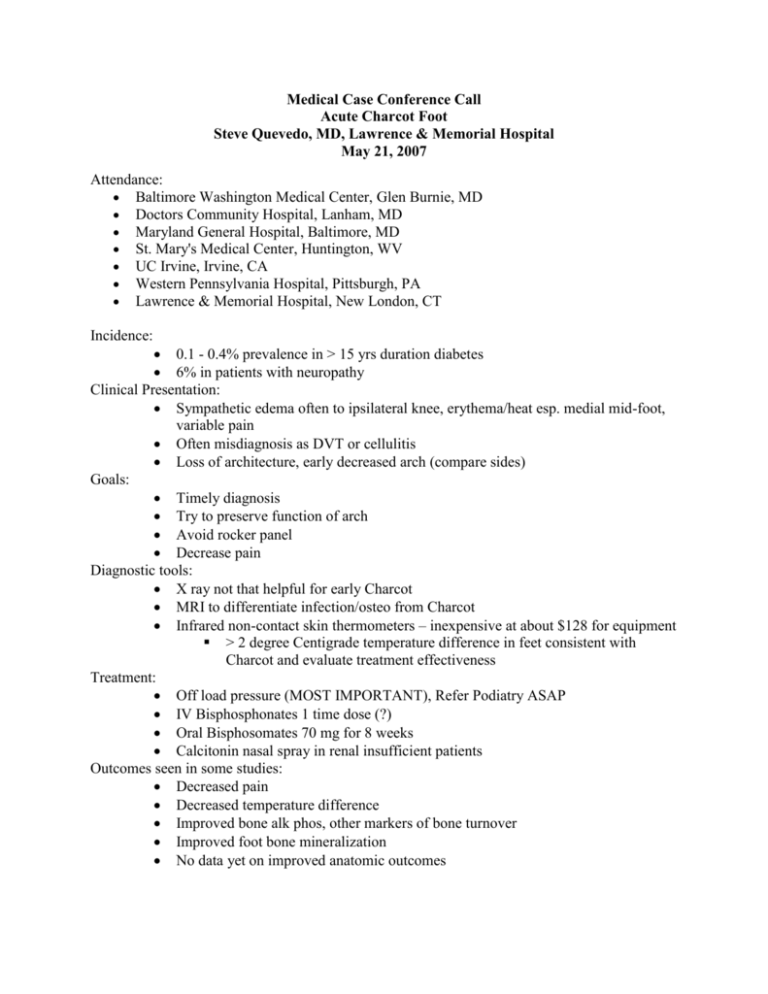
Medical Case Conference Call Acute Charcot Foot Steve Quevedo, MD, Lawrence & Memorial Hospital May 21, 2007 Attendance: Baltimore Washington Medical Center, Glen Burnie, MD Doctors Community Hospital, Lanham, MD Maryland General Hospital, Baltimore, MD St. Mary's Medical Center, Huntington, WV UC Irvine, Irvine, CA Western Pennsylvania Hospital, Pittsburgh, PA Lawrence & Memorial Hospital, New London, CT Incidence: 0.1 - 0.4% prevalence in > 15 yrs duration diabetes 6% in patients with neuropathy Clinical Presentation: Sympathetic edema often to ipsilateral knee, erythema/heat esp. medial mid-foot, variable pain Often misdiagnosis as DVT or cellulitis Loss of architecture, early decreased arch (compare sides) Goals: Timely diagnosis Try to preserve function of arch Avoid rocker panel Decrease pain Diagnostic tools: X ray not that helpful for early Charcot MRI to differentiate infection/osteo from Charcot Infrared non-contact skin thermometers – inexpensive at about $128 for equipment > 2 degree Centigrade temperature difference in feet consistent with Charcot and evaluate treatment effectiveness Treatment: Off load pressure (MOST IMPORTANT), Refer Podiatry ASAP IV Bisphosphonates 1 time dose (?) Oral Bisphosomates 70 mg for 8 weeks Calcitonin nasal spray in renal insufficient patients Outcomes seen in some studies: Decreased pain Decreased temperature difference Improved bone alk phos, other markers of bone turnover Improved foot bone mineralization No data yet on improved anatomic outcomes Case #1 Inpatient Consult Admitted with pain and erythema, no elevated white count or fever - suspected cellulitis Obese Consultation with Joslin requested for newly diagnosed diabetes not for foot A1C 10.2% Suspected Charcot Bed rest helped MRI looked like cellulitis IV pamidronate - improvement in 24-48 hrs in pain/erythema Case #2 Twenty year hx Type 2 DM, peripheral neuropathy, obese and hx Charcot Diabetes in control A1C down to low 6 on Metformin & Byetta Foot exam as part of routine follow up visit for diabetes Infrared thermometer showed 5 degree C difference in feet Immediate podiatry consult Off load Fosomax 70 mg weekly x 8 weeks Case #3 Long standing type 1 triopathy, heel callous infection treated and healed Routine diabetes follow up visit – new asymmetric edema not near infection site Immediate off load Calcitonin nasal spray because of renal insufficiency 3 month follow up - not totally compliant with off load, edema improved but heat difference 3.2 degree, Vit D deficiency diagnosed and treated. Off load again. Limping because of heal infection or increased blood flow from infection (?) may have predisposed to Charcot Case #4 Type 2 morbidly obese, peripheral neuropathy Insulin & Byetta & Metformin Foot exam during routine follow up - edema, no temp gradient could be felt, arch slightly flattened, Michigan Neuropathy score 3 Patient reported he was in ER several times recently for foot problem, treated with bed rest, IV & oral antibiotics, negative DVT, pain in medial foot resolved A1c 6.0-6.5% Infrared thermometer result 1.8 – 2.1 temp differential MRI classic for Charcot Back on bed rest At follow up down to 1 – 1.3 temp difference Treatment and compliance with “cellulitis” (ie bed rest) probably stopped progress of Charcot even though not diagnosed 2 Lessons learned Look for Charcot; foot exams on every routine visit Infrared thermometer whenever suspect Charcot and order MRI if > 2 degree C temperature difference between feet; Infrared thermometer can’t distinguish cellulitis from Charcot Danger of type 2 at younger age could increase incidence Not billing for Infrared thermometer – only takes a minute High risk patients can be taught to use their own thermometer Talk about Charcot with podiatrists and PCPs Teach patients with PDR early symptoms of Charcot References: 1) Tan AL. Acute Neuropathic Joint Disease: A Medical Emergency? Diabetes Care 2005;28:2962-4 2) Jeffcoate W. A Concise Review of the Charcot Foot. Diabetic Med 2000;17:253-58 3) Ahmadi ME. Neuropathic Arthropathy with and without Osteomyelitis: MRI Characteristics. Radiology 2006;238:622-31 4) Armstrong DG. Natural History of Acute Charcot Arthropathy. Diabetic Med 1997;14:357-63 5) Monitoring Healing of Acute Charcot Foot with Infrared Thermometry. Rehabil Res Dev 1997;34: 317-21 6) Jude EB. IV Pamidronate For Treatment of Acute Charcot. Diabetologia 2001;44: 2032-37 7) Pitocco D. Six Months of Alendronate Therapy for Acute Charcot. Diabetes Care 2005;28:1214-15 8) Bem R. Intranasal Calcitonin for Therapy of Acute Charcot. Diabetes Care 2006;29:1392-94 3
